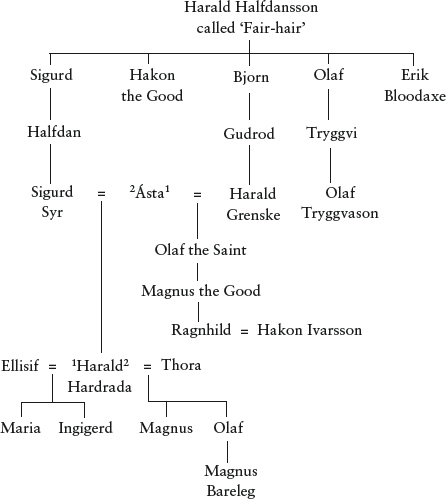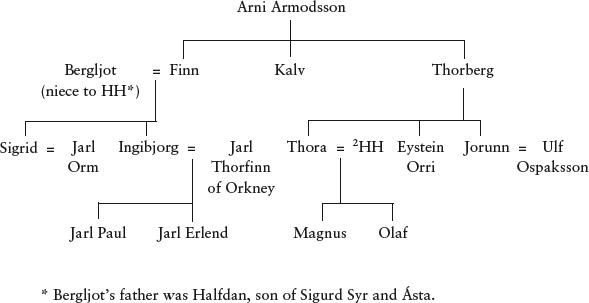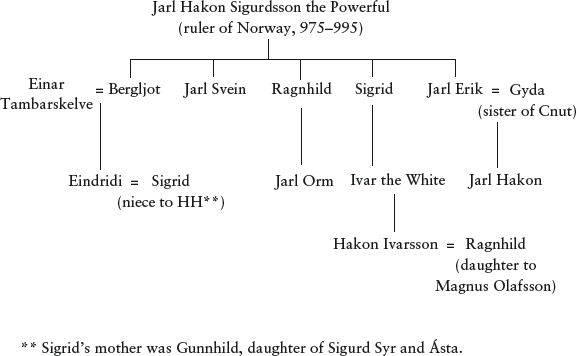Harald Hardrada (35 page)
Authors: John Marsden

AN AFTERWORD FROM WEST-OVER-SEA
N
othing further is told of Harald's famous standard in the saga after Eystein Orri had retrieved the banner from wherever it had been abandoned when Tostig was slain and raised it up again to lead his warriors in the last desperate stand remembered as âOrri's Battle'. At which point
Landeyðuna
disappears entirely from the saga record and might be thought to have been lost for ever amid the blood-stained debris left lying along the bank of the Derwent water. Yet it need not be so, because there is reason to believe that the celebrated Land-ravager was not only rescued from the field of Stamford Bridge but eventually found its way to a westward region of the Scandinavian expansion where Harald himself had no occasion to travel but where his grandson, Magnus Olafsson â called âBareleg' on account of his adoption of the garb of the Gael â is well remembered as the warrior king who finally and formally claimed the Hebrides (or
Suðreyjar
) for Norway in 1098.
In the room thought to have been the original Great Hall of Dunvegan Castle on the Isle of Skye is displayed a broad fragment of textile known in the Gaelic as
Am Bratach Sidhe
(or âThe Fairy Flag') and long regarded as the most treasured possession of the Clan Macleod, whose principal stronghold this fortress is said to have been since the fourteenth century when the name Macleod made its first entry into the historical record. At least half a dozen stories are told of how this âFairy Flag' came into the possession of the Macleods of Dunvegan â some claiming it to have been a gift of the fairy folk (and, indeed, the bridge where that gift was made is clearly signalled to any modern visitor who might pass that way), while others say it was brought from the Holy Land by a clansman returning from a crusade. There are problems with both of these traditions, firstly by reason of the unreliable historicity of fairies and secondly because there appears to be no record of any Macleod known to have been on any of the crusades.
Another feature of the traditions surrounding this
Bratach Sidhe
is the belief in its power to save the clan in times of danger and Macleod chieftains are said to have twice unfurled the flag when hard-pressed in battle and thus to have won the victory. It is this claim â and the possibility of its association with the Fairy Flag long before it came into the hands of the Macleods â which points toward the genuinely historical proposal that
Am Bratach Sidhe
is, in fact, Harald Hardrada's
Landeyðuna
.
Clan Macleod has always been proud of its Gaelic-Norse origins and justly so because their line has been convincingly traced all the way back to Olaf Cuaran, Norse king of York and of Dublin, who died the âstraw death' in monastic retirement on Iona in 981. The Leod for whom the clan is named, however, was directly descended from the line of the Norse kings of Man and the Isles through one Helga âof the beautiful hair' who was the sister of the same Godred Crovan who fought with the Norwegian army at Stamford Bridge and survived the battle to become the founding dynast of the royal house of Man.
The entry under the year 1066 in the thirteenth-century
Chronicle of Man
refers to the âvery great slaughter of the Norwegians' at Stamford Bridge and tells of âGodred, called
Crovan
, son of Harald the Black from
Island
[thought to mean the Isle of Islay], fleeing from the rout' and making his escape (probably overland by way of North Wales or the Solway) to the Isle of Man. The saga account of the phases of the conflict would almost certainly indicate the ârout' referred to by the
Chronicle
as âOrri's Battle', in the course of which Land-ravager disappears from the historical record. If Godred had brought a banner, probably made of silk and assuredly of Byzantine origin, back from Stamford Bridge, he could very well have made a gift of it to his sister and assuredly also spoken of the legendary powers associated with its service as Harald's battle-flag.
All of which might be thought to correspond quite impressively to the proposal of Land-ravager having been handed down the generations of Helga's descendants even to the present Macleod of Macleod in whose castle at Dunvegan it is revered as
Am Bratach Sidhe
. Still more impressive, though, are the results of a modern forensic examination of the fabric of the Fairy Flag identifying it as a silk at least as old as the seventh century and of eastern origin, probably from Rhodes or possibly from Syria, both of which were sources supplying this greatly prized textile to the Byzantines.
If the Fairy Flag of the Macleods really is the same Land-ravager banner which Harald is said to have valued above all other treasures in his possession, then its location on Skye offers a quite remarkable coincidence, because to the south-east of Dunvegan stands the magnificent mountain range known as the Cuillin.
Once again, the claims of âCeltic' tradition might stand accused of clouding the issue and not least through the efforts of Sir Walter Scott who played a great part in associating âCuillin' with the legendary Irish hero Cuchullain. In fact, the true origin of the name, alike to that of the other Cuillin on the neighbouring island of Rum, derives from the Old Norse â
kjolr
(âthe keel') or
kiolen
(âhigh rocks') â and so the Cuillin of Skye can be said to share its name with the Kjolen range over which the young Harald Sigurdsson, having recovered from wounds suffered at Stiklestad, crossed from Norway into Sweden along that early passage of his warrior's way.
There is just one abbreviation: HH = Harald Hardrada
DESCENT OF HARALD HARDRADA AND HIS SUCCESORS FROM HARALD FAIR-HAIR

Â
THE ARNASONS AND THEIR NETWORK OF MARITAL KINSHIP

Â
THE JARLS OF LADE AND THEIR DESCENDANTS

Introduction
1. Magnusson & Pálsson (ed.),
King Harald's Saga
, p. 31.
2. Turville-Petre,
Haraldr the Hard-ruler and his Poets
, p. 5.
3. Blöndal & Benedikz,
The Varangians of Byzantium
, p. 210.
4. Turville-Petre,
Haraldr the Hard-ruler and his Poets
, pp. 3â4.
1. Turville-Petre,
The Heroic Age of Scandinavia
, p. 156.
2. Jones,
A History of the Vikings
, p. 382.
3. In the twelfth-century saga texts, however, Russia is identified by the later Icelandic name-form of
GarðarÃki
.
4. While the saga actually specifies âfour hundred chosen men', such references are calculated in âlong hundreds', or 120 in modern reckoning, and so the reinforcement would have amounted to 480 of Onund's warriors. That same formula is applied here to all troop and ship numbers found in the saga texts, although such figures should usually be considered only as approximations.
5. Foote & Wilson,
The Viking Achievement
, p. 284.
6. âWeapon thing' is one of many skaldic kennings for âbattle'.
7. Foote & Wilson,
The Viking Achievement
, p. 80.
8. Although usually translated as âpaunch-shaker', the original meaning may have been âhe who twangs the bow-string' and a reference to his part in the battle of Svold where the young Einar fought as an archer aboard Olaf Tryggvason's ship.
9. Thorstein's surname translates as âknorr-maker', from the trading ship type known as a
knorr
.
10. Jacqueline Simpson (ed.),
The Olaf Sagas
, p. 381.
11. By âthe Finns' is meant the Lapps, who are also a FinnoâUgrian people.
12. Turville-Petre,
Haraldr the Hard-ruler and his Poets
, p. 10.
1. Known in Russian as
Povest' Vremennykh Let
, a title literally translated as âTale of the Years of Time'.
2. Franklin & Shepard,
The Emergence of Rus
, p. 201.
3. Blöndal & Benedikz,
The Varangians of Byzantium
, pp. 54â5.
4. Her eldest sister, Eudocia, had long since become a nun, thus effectively renouncing her claim on succession.
5. Blöndal & Benedikz,
The Varangians of Byzantium
, p. 75.
6.
Ibid
., p. 66.
7. Pritsak, âVarangians', in Pulsiano (ed.),
Medieval Scandinavia: An Encyclopedi
a, p. 689.
8. Gravett,
Norman Knight
: 950â1204
AD
, p. 60.
9. Obolensky,
The Byzantine Commonwealth
, pp. 84, 160.
10. Norwich,
A Short History of Byzantium
, p. 222.
11. Blöndal & Benedikz,
The Varangians of Byzantium
, pp. 80â6.
12.
Ibid
., pp. 97â8.
13. Harald's actual phrase is âgold-[arm]ring
Gerðr
';
Gerðr
being the name of the wife of the god Frey and used as a skaldic kenning to mean âgoddess' in the complimentary sense of the term when applied to a mortal woman.
14. âGreek Fire' is thought to have been distilled petroleum thickened with sulphurous resin, which burst into flame on contact with enemy vessels and continued to burn on the water.
15. Franklin & Shepard,
The Emergence of Rus 750â1200
, p. 216.
16. Obolensky,
The Byzantine Commonwealth
, p. 225.
1. Jones,
A History of the Vikings
, p. 404.
2.
Ibid
., p. 401.
3.
Ibid
., p. 407.
4. Davidson,
The Viking Road to Byzantium
, pp. 221, 228.
5. If Stein's figures are given in âlong hundreds', as they probably are, then 150 Norwegian and 300 Danish ships would represent 180 and 360 respectively in modern reckoning, although such precision is of little bearing here.
1. DeVries,
The Norwegian Invasion of England in 1066
, p. 238.
2. Jones,
A History of the Vikings
, p. 403.
3. DeVries,
The Norwegian Invasion of England in 1066
, p. 230.
4.
Ibid
., p. 211.
5.
Ibid
., p. 204.
6. Broadhead,
Yorkshire Battlefields
, p. 41.
7. Turville-Petre,
Haraldr the Hard-ruler and his Poets
, p. 17.
8. DeVries,
The Norwegian Invasion of England in 1066
, pp. 278â9.
9. There are different forms of translation of these words, but this (from DeVries, p. 284) is the most accurate.
Adam of Bremen,
History of the Archbishops of Hamburg-Bremen
(trans. F.T. Tschan), New York, 1959
Anderson, A.O. (trans.),
Early Sources of Scottish History
AD
500â1286
, 1922, repr. Stanford, 1991
Anglo-Saxon Chronicle, The
(trans. G.N. Garmonsway), London, 1972
Blöndal, S. and Benedikz, B.S. (trans. and rev.),
The Varangians of Byzantium
, Cambridge, 1978